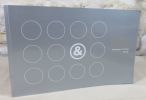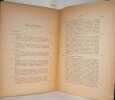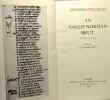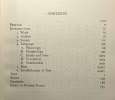630 books for « bell e t »Edit
-
Type
Book (613)
Engraving (8)
Music sheets (8)
Posters (1)
-
Latest
Last 24h (2)
Last month (8)
-
Language
English (6)
French (623)
Russian (1)
-
Century
17th (1)
18th (6)
19th (62)
20th (275)
21st (46)
-
Countries
Belgium (45)
Canada (2)
China (2)
Côte d'Ivoire (1)
Denmark (10)
France (498)
Germany (1)
Switzerland (69)
United Kingdom (1)
United States of America (1)
-
Syndicate
ALAC (2)
CLAM (4)
ILAB (224)
NVVA (6)
SLACES (6)
SLAM (196)
Topics
- American literature (5)
- Ampelography - wines (4)
- Andersen hans christian (3)
- Animals (3)
- Archaeology (4)
- Assembly (32)
- Atlas (3)
- Aviation (3)
- Biography (7)
- Books from the xviiith (2)
- Brittany (2)
- Carpenter (5)
- Children’s books (6)
- China (6)
- Comic strip (28)
- Commune (2)
- Computer science (3)
- Cooking (4)
- Education (2)
- Electricity (2)
- England (6)
- English (10)
- English literature (2)
- Engravings (3)
- Ethic (4)
- Fashion (5)
- Fielding helen (2)
- Fine arts (8)
- First edition (10)
- Flanders (24)
- Fox (2)
- Games toys (2)
- Genealogy (2)
- Geography (5)
- Gold (29)
- Guide books (2)
- Hackney (3)
- History (20)
- Hugo victor (3)
- Illustrated books (2)
- Industrial arts & crafts - fine arts (3)
- Invertebrates (3)
- Ireland (2)
- Italian (2)
- Language (5)
- Latin (4)
- Law (3)
- Leisure (3)
- Literature (64)
- Magazine (34)
- Mathematics (7)
- Medicine (9)
- Melville herman (3)
- Méry (3)
- Morin edgar (2)
- Motor vehicle (9)
- Mountaineering climbing (2)
- Newspapers press (4)
- Paris (3)
- Philosophy (6)
- Photography (4)
- Physics (4)
- Plate (3)
- Policy (5)
- Reading vocabulary (2)
- Regency (32)
- Religions (11)
- Review (2)
- Reviews (4)
- Rock (2)
- Science fiction (2)
- Sciences (7)
- Scores (9)
- Sexuality (2)
- Socialism (2)
- Songs (7)
- Surgery (7)
- Tales (3)
- Tea (34)
- Theatre (2)
- Theology (5)
- Tibet (6)
- Tibet pc (6)
- Translation (7)
- Turkey - ottoman empire (2)
- United kingdom (5)
- Various (9)
- Viticulture (5)
- War (4)
- Wine (7)
- Woolf virginia (3)
- Zoology (4)
(Untitled) Animated Discourse
Venice California, Sure Co, 1975, 128x382mm, 146 pages non paginées composées chacune de 42 images (72 pour la page 1) juxtaposées pour former un texte photographique. Cartonné, couvertures muettes recouvertes de papier argenté.
Une bande jointe 26x1505mm, fournit la correspondance image-lettre; elle se loge dans le troisième de couverture, protégée par une feuille de plastique transparent. Le texte codé a été emprunté au situationniste Raoul Vaneigem.Signé par les deux auteurs. Tirage de1000 exemplaires dont 900 furent détruits par l'imprimeur (voir la monographie de Larry Bell parue aux Presses du Réel)Ref. Larry Bell, Les Presses du Réel 2010, p20-21, reproduit. (104937)
Phone number : +33 1 48 01 02 37
Une si jolie petite fille. Les crimes de Mary Bell.
Broché, 22X14 cm, 2014, 438 pages, éditions plein jour. Très bon état.
The Spell of China.
New York, The Page Company, 1917. In-8 de XIV-404 pp, bibliographie, index, 54 planches photographiques hors texte, percaline décorée de l'éditeur.
Édition originale illustrée de 54 planches de photographies.Voyage en Chine du journaliste, critique dramatique et musical américain Archie Bell (1877-1943) qui visita Hong Kong, Canton, Macao, puis rallia Shanghai. Il se dirigea ensuite vers l'ouest le long du Yangtsé, visitant Nankin, Kiukiang (Jiujiang) et Hankow, où il monta à bord d'un train pour Pékin. Il acheva son périple à Tsingtao et en Corée occupée par le Japon. Bel exemplaire sans la carte dans son cartonnage éditeur.
Le livre de de la manufacture.
Broché, 15X23 cm (à l'italienne), catalogue 2003/2004, 142 pages, nombreuses photos en noir et en couleurs. Bon exemplaire.
"BELL, ALEXANDRE (ALEXANDER) GRAHAM. - BELL, ALEXANDER GRAHAM. - ""THE GREATEST INVENTION I HAVE EVER MADE"": THE PHOTOPHONE.
Reference : 48149
(1880)
De la Production et de la Reproduction du Son par la Lumière. Mémoire lu à l'Association américaine pour l'avancement des Sciences, au Congrès de Boston, le 27 août 1880. (+) Les Récepteurs photophoniques de Sélénium. (Cette Note fait suite au M´wem...
Paris, G. Masson, 1880. 8vo. Contemp. hcalf, raised bands, gilt spine. Light wear along edges. Small stamps on verso of titlepage. In: ""Annales de Chimie et de Physique"", 5e Series, Tome 21. 576 pp. and 2 folded engraved plates. (Entire volume offered). Bell's paper: 399-430. With 11 fine textillustrations (showing the apparatus). Clean and fine.
First French version of ""On the Production and Reproduction of Sound by Light"" (the French version published in November and the English in October 1880) of this importent paper in which Bell describes his and Charles Sumner Tainter's, his assistent, invention of the Photophone or Radiophone, THE PROGENITOR OF MODERN FIBER OPTICS. This invention made possible the world's FIRST WIRELESS TELEPHONE MESSAGE, and the first call was sent from the Franklin Scool to the window of Bell's laboratory, some 213 meter away.Also with Breguet's importent paper on the Selenium used in the technology.""On June 3, 1880, Alexander Graham Bell transmitted the first wireless telephone message on his newly invented ""photophone."" Bell believed the photophone was his most important invention. The device allowed for the transmission of sound on a beam of light. Of the eighteen patents granted in Bell's name alone, and the twelve he shared with his collaborators, four were for the photophone. Bell's photophone worked by projecting voice through an instrument toward a mirror. Vibrations in the voice caused similar vibrations in the mirror. Bell directed sunlight into the mirror, which captured and projected the mirror's vibrations. The vibrations were transformed back into sound at the receiving end of the projection. The photophone functioned similarly to the telephone, except the photophone used light as a means of projecting the information, while the telephone relied on electricity."" (Mary Bellis).The first successful attempts were based upon the properties of selenium: ""The electric resistance of which varies with the degree of illumination to which it is exposed. Hence, given a transmitting instrument, such as a flexible mirror, by which the vibrations of a sound could throw into vibrations a beam of light, a receiver, consisting of sensitive selenium, forming part of an electric circuit with a battery and a telephone, should suffice to translate the varying intensities of light into corresponding varying intensities of electric current, and finally into vibrations of the telephone disk audible once more as sound."" (Prescott, George. Bell's Electric Speaking Telephone. 313 p.).
"BELL, ALEXANDER GRAHAM. - ""THE GREATEST INVENTION I HAVE EVER MADE"": THE PHOTOPHONE.
Reference : 46951
(1880)
On the Production and Reproduction of Sound by Light. (Read before the American Association for the Advancement of Science, in Boston, August 27, 1880).
(New Haven), 1880. 8vo. Modern plain wrappers. In: American Journal of Science"", Third series, Vol. XX, No. 118, October 1880. Frontispiece-plate. Pp. 257-352 (entire issue offered). Bell's paper: pp. 305-324 and 11 textillustrations. A small stamp to verso of plate and the first leaf.
First printing of this important paper in which Bell describes his and Charles Sumner Tainter's, his assistent, invention of the Photophone or Radiophone, THE PROGENITOR OF MODERN FIBER OPTICS. This invention made possible the world's FIRST WIRELESS TELEPHONE MESSAGE, and the first call was sent from the Franklin Scool to the window of Bell's laboratory, some 213 meter away.""On June 3, 1880, Alexander Graham Bell transmitted the first wireless telephone message on his newly invented ""photophone."" Bell believed the photophone was his most important invention. The device allowed for the transmission of sound on a beam of light. Of the eighteen patents granted in Bell's name alone, and the twelve he shared with his collaborators, four were for the photophone. Bell's photophone worked by projecting voice through an instrument toward a mirror. Vibrations in the voice caused similar vibrations in the mirror. Bell directed sunlight into the mirror, which captured and projected the mirror's vibrations. The vibrations were transformed back into sound at the receiving end of the projection. The photophone functioned similarly to the telephone, except the photophone used light as a means of projecting the information, while the telephone relied on electricity."" (Mary Bellis).The first successful attempts were based upon the properties of selenium: ""The electric resistance of which varies with the degree of illumination to which it is exposed. Hence, given a transmitting instrument, such as a flexible mirror, by which the vibrations of a sound could throw into vibrations a beam of light, a receiver, consisting of sensitive selenium, forming part of an electric circuit with a battery and a telephone, should suffice to translate the varying intensities of light into corresponding varying intensities of electric current, and finally into vibrations of the telephone disk audible once more as sound."" (Prescott, George. Bell's Electric Speaking Telephone. 313 p.).
De la production du son par l'energie radiante. - [FIRST FRENCH PUBLICATION OF BELL'S PHOTOPHONE]
Paris, Imprimerie Gauthier-Villars, 1881. 8vo. Contemporary half calf, raised bands, gilt spine. Light wear along edges. Two small stamps on verso of title-page, and one on verso of last plate. In ""Annales de Chimie et de Physique"", Cinquiéme Series - Tome XXIII. 576 pp. + 3 plates. G. Bell's paper: pp. 397-432, pp. and 14 figures of experimental apparatus etc. The entiree volume offered. Fine and clean copy.
First publication of the first French translation of Bell's ""On the Production and Reproduction of Sound by Light: the Photophone"", originally published in 1880. The device allowed for the transmission of sound on a beam of light, and Bell himself regarded this, not the telephone, to be his most important invention.""In the importance of the principles involved, I regard the photophone as the greatest invention I have ever made"" greater than the telephone."" Bell said in a 1921 interview. The photophone was the world's first wireless telephone communication and thereby anticipated Marconi's invention with several years.The first successful attempts were based upon the properties of selenium: ""The electric resistance of which varies with the degree of illumination to which it is exposed. Hence, given a transmitting instrument, such as a flexible mirror, by which the vibrations of a sound could throw into vibrations a beam of light, a receiver, consisting of sensitive selenium, forming part of an electric circuit with a battery and a telephone, should suffice to translate the varying intensities of light into corresponding varying intensities of electric current, and finally into vibrations of the telephone disk audible once more as sound."" (Prescott, George. Bell's Electric Speaking Telephone. 313 p.).Bell was so excited by his invention and its possibilities that he proposed that his second daughter should bear the name of the invention: Photophone. Fortunately for her, her mother was not quite as enthusiastic about the invention.
The end of ideology
Collier books 1961 in12. 1961. Broché.
Bon Etat couverture défraîchie intérieur propre dos un peu creusé et ridé ex-libris
Frege's Theory of Judgement
OXFORD UNIV PR 1979 178 pages in8. 1979. Cartonné jaquette. 178 pages.
Très bon état avec sa jaquette ex-libris
Étude sur le songe du vieil pelerin de Philippe de Mézières ( 1327-1405 ) D'après le manuscrit français B.N. 22542 Documents historique et moral du règne de Charles VI
E. droz 1955 208 pages in-8. 1955. broché. 208 pages.
Marges brunies
Contradictions culturelles du capital
Puf 1979 296 pages 16x3 7x23cm. 1979. Broché. 296 pages.
Bon état de conservation intérieur propre bonne tenue tranche tachée en tête
Manual of Colloquial Tibetan
Calcutta Calcutta, Baptist Mission Press, 1905. In-8 relié cartonnage éditeur rouge, dos refait de 457 pages. Manque les quatre premières pages de préface. Edition originale, peu courante. En l'état
Toutes les expéditions sont faites en suivi au-dessus de 25 euros. Expédition quotidienne pour les envois simples, suivis, recommandés ou Colissimo.
Jane eyre ou les mémoires d'une institutrice TOME PREMIER + SECOND (compilés en un volume) - traduit par Lesbazeilles Souvestre
Hachette et cie 1883 in12. 1883. Relié.
Bon Etat de conservation bords frottés coins émoussés tranche ternie intérieur globalement propre qques rousseurs
Virginia Woolf - A biography - volume one - virginia stephen 1882-1912
The Hogarth Press 1972 in8. 1972. Relié.
couverture légèrement défraîchie tranches légèrement fânées intérieur propre
Juden und griechen im römischen alexandreia - eine historische skizze des alexandrinischen antisemitismus / Beihefte zum Alten Orient
J.C. Hinrichs'sche buchhandlung 1927 52 pages in8. 1927. Broché. 52 pages. iconographie en noir et blanc
couverture défraîchie bords frottés rousseurs à l'intérieur
Le soulèvement des âmes
Actes Sud Actes Sud, 1996. In-8 broché de 597 pages. Très bon état
Toutes les expéditions sont faites en suivi au-dessus de 25 euros. Expédition quotidienne pour les envois simples, suivis, recommandés ou Colissimo.
L'anglicanisme - Coll. Les religions
Presses universitaires de France 1939 in12. 1939. broché.
Bon Etat de conservation intérieur propre tampon ex libris surligné sur le faux titre sous papier de soie rousseurs sur tranche
An anglo-norman brut (royal 13. A. xxi) - anglo-norman texts XXI-XXII
Anglo-Norman text society 1969 in8. 1969. Cartonné.
Bon état couverture défraîchie intérieur propre texte en anglais et anglo-norman
L'anglicanisme - Les religions
Presses universitaires de france 1939 in12. 1939. Broché.
Bon état sous papier de soie intérieur propre qq rousseurs sur tranche de tête intérieur propre
Loraine John Alexander Bell Edwin Trevor
Reference : 100070438
(1971)
ISBN : 0443007381
Hormone Assays and Their Clinical Application
Harcourt Brace/Churchill Livingstone 1971 703 pages 17x23x3cm. 1971. Cartonné jaquette. 703 pages.
bon état général intérieur propre jaquette frottée sur ses bords accroc en haut de son dos
Le livre du vin tous les vins du monde
Deux coqs d'or 1973 315 pages in4. 1973. Relié jaquette. 315 pages.
Etat Correct tranche jaunie
Noces d'hiver
Le club français du livre 1953 255 pages in12. 1953. Relié. 255 pages.
etat correct exemplaire n°002237 taches rousseurs tranche
Remembered Kisses: An Illustrated Anthology of Irish Love Poetry (texte anglais)
Gill Books 2000 143 pages in8. 2000. Broché. 143 pages. illustrations en couleurs
Très Bon Etat de conservation
 Write to the booksellers
Write to the booksellers





































